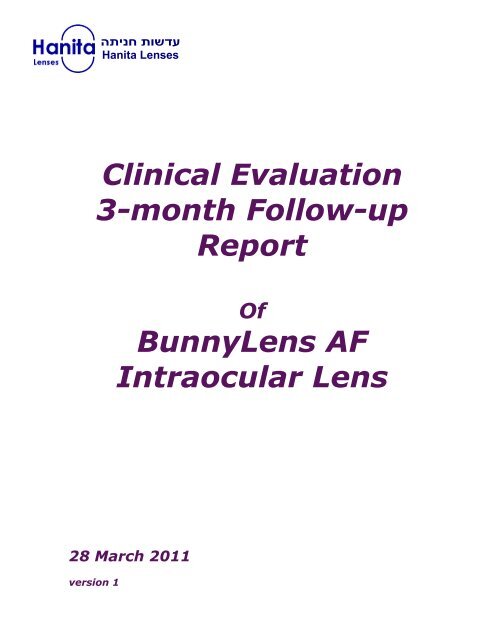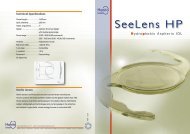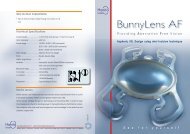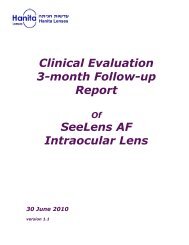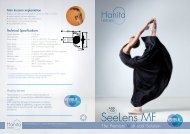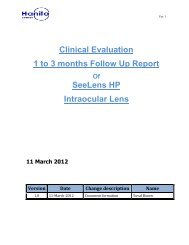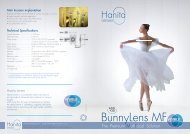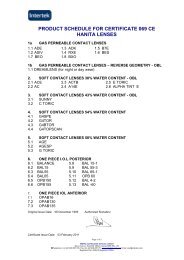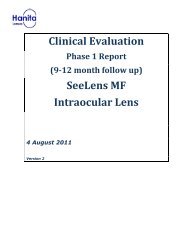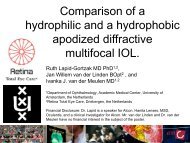BunnyLens AF - Hanita Lenses
BunnyLens AF - Hanita Lenses
BunnyLens AF - Hanita Lenses
- No tags were found...
Create successful ePaper yourself
Turn your PDF publications into a flip-book with our unique Google optimized e-Paper software.
עדשות חניתה<strong>Hanita</strong> <strong>Lenses</strong>Clinical Evaluation3-month Follow-upReportOf<strong>BunnyLens</strong> <strong>AF</strong>Intraocular Lens28 March 2011version 1
Page 3 of 22Objectives:The objective of this study is to evaluate the safety and efficacy of the <strong>BunnyLens</strong> <strong>AF</strong> IOL, implantedfollowing cataract removal by phacoemulsification.1. The key efficacy parameters are:Primary:- Best Corrected Visual Acuity (BCVA)- Predictability of refractive correctionSecondary:- Un Corrected Visual Acuity (UCVA) – for data gathering only2. The key safety parameters include:- IOL behavior during implantation and follow-up- IOL related infection and/or inflammatory reactionsEfficacy and Safety AssessmentsThe efficacy and safety assessments were determined as defined by and according to ISO11979 directive. The following are the requirements of the directive:1. Post Operative BCVA of at least 6/12 (20/40) within 88% of patients' population. For the"best cases" patients, BCVA 6/12 (20/40) or better, for at least 94% of the patients.(Requirements defined by ISO 11979-7 2006 for a sample size of 100 patients).2. IOL related Post Operative complication and Adverse Events equal to or less then theallowed rate defined by ISO 11979-7 2006.High order aberrations / Spherical aberrations were evaluated in one medicalcenter (BEAR Institute, Berlin). Total aberrations should be statistically significantlower then reported literature data for spheric lenses.<strong>Hanita</strong> <strong>Lenses</strong> Intraocular & Contact <strong>Lenses</strong>עדשות חניתהעדשות מגע ועדשות השתלה תוך-עינית•קיבוץ חניתה • 88222 www.hanitalenses.com Kibbutz <strong>Hanita</strong> 22885 Israel • Tel. 972-4-9950 700• Fax: 972-4-9950 755 •
Page 5 of 22Figure 1: <strong>BunnyLens</strong> <strong>AF</strong> Intraocular lens2. <strong>BunnyLens</strong> <strong>AF</strong> designa. Motivation – visual acuity<strong>Hanita</strong> <strong>Lenses</strong> search for vision quality improvements has a shared objective for bothrefractive and cataract surgery. The main goal for the refractive and cataract surgery is toprovide the patient with the best visual acuity and good post operative refraction that currenttechnology allows.The quest for an improved visual acuity for the cataract patient led <strong>Hanita</strong> <strong>Lenses</strong> to developan aspheric-shaped lens, designed to allow the patient a sharper image in the regular photopicvision (daylight vision), and reduce the aberrations of mesopic and scotopic vision (twilightand night vision), which are noticed by some of the conventional spherical Intra Ocular Lensimplanted patients.Figure 2:The Black line defines the photopic vision and the green line defines the scotopic vision.The area between the graphs defines the scotopic vision.<strong>Hanita</strong> <strong>Lenses</strong> Intraocular & Contact <strong>Lenses</strong>עדשות חניתהעדשות מגע ועדשות השתלה תוך-עינית•קיבוץ חניתה • 88222 www.hanitalenses.com Kibbutz <strong>Hanita</strong> 22885 Israel • Tel. 972-4-9950 700• Fax: 972-4-9950 755 •
Page 6 of 22b. Spherical aberration:The spherical aberration is a well known phenomenon in the optic field. The sphericalaberration occurs when rays of light that pass through different parts of the lens intersect atdifferent points on the optical axis of the lens (Figure 3). Due to this aberration, a dotprojected on the retina produces a larger circle, thus inducing low quality optics, an unclearvision and low contrast (Figure 4).Figure 3:Spherical AberrationFigure 4:A demonstration of the blur caused by spherical aberration with awider pupil. The rays that enter the retina from far scatter differentlyand are projected blurredly to the retina, causing a law quality image.Contributors to spherical aberration (SA) in the eye are the cornea (average +0.27 m) andthe crystalline lens (negative in the young eye). Cataract surgery removes the lens componentand leaves positive SA on average. Traditional intraocular lenses (IOLs) are spherical withpositive SA, further increasing the SA of the pseudophakic eye.c. Clinical demand:As it gets darker and the pupil dilates, the spherical aberration becomes more apparent, andstarts to be noticeable by the patient. Thus patients with conventional spherical lensescomplain of unclear vision and poor contrast in the mesopic and scotopic conditions.d. Lens Design:There are three options to optimize lens surface:1) Aberration free lens- all aberrations of the eye remain.2) Reduce spherical aberration to zero (theoretically for 6mm pupils).3) Optimize the lens surface to achieve best functional visual acuity.The <strong>BunnyLens</strong> <strong>AF</strong> was designed using the third option: obtaining maximum ContrastSensitivity by optimizing the Modulated Transfer Function using Arizona eye model designedto match clinical levels of aberration, both on and off axis (the model is based on Navarro eyemodel and the Koojiman model and uses eye modeled for a 60 year old patient).The <strong>BunnyLens</strong> <strong>AF</strong> optical design was performed using the symmetric aspheric surfaceequation described below.<strong>Hanita</strong> <strong>Lenses</strong> Intraocular & Contact <strong>Lenses</strong>עדשות חניתהעדשות מגע ועדשות השתלה תוך-עינית•קיבוץ חניתה • 88222 www.hanitalenses.com Kibbutz <strong>Hanita</strong> 22885 Israel • Tel. 972-4-9950 700• Fax: 972-4-9950 755 •
Page 7 of 22C = 1/R: R – Radius of curvature.K- Conic ConstantR – Radial distance from optical axis.The theoretical asphericity value of <strong>BunnyLens</strong> <strong>AF</strong> for 6mm pupil opening was calculatedusing ZEMAX simulation: IOL asphericity: -0.14µm Total Spherical Aberration of an eye: +0.13µmThis pupil opening was used to compare <strong>BunnyLens</strong> <strong>AF</strong> with other aspheric IOLs available inthe market.Table 1 – Spherical aberrations for different aspheric IOLs, 6mm pupil opening:LensIOLasphericity[µm]Total sphericaberration[µm]Spheric IOL +0.18 +0.45AMO Tecnis -0.27 0Alcon IQ -0.2 +0.07ReStore aspheric -0.1 +0.17Staar Afinity -0.02 +0.25B&L sofport AO 0 +0.27<strong>BunnyLens</strong> <strong>AF</strong> -0.14 +0.13The key concept of the design was the definition of the way the eye perceives shapes underthe various conditions of contrast and luminance. The underlying principles of the concept arethe analysis of contrast vision and the MTF – The Modulated Transform Function.Optimizations of these parameters lead to the <strong>BunnyLens</strong> <strong>AF</strong> Visual Acuity improvement.In order to confirm accurate perception of image quality by the new designed optics, the<strong>BunnyLens</strong> <strong>AF</strong> optic design relies on the MTF (Modulation Transfer Function), the best toolfor objective quantitative measurement of visual performance and contrast sensitivity.The MTF is also an extremely sensitive measure of image quality degeneration, enabling anaccurate evaluation of the aberration degree.The <strong>BunnyLens</strong> <strong>AF</strong> exceed the standard spherical intraocular lenses, ensuring improvedquality of image and high contrast sight sensitivity for a higher range of spatial frequencies.This advantage is kept even at difficult visual situations, such as low light conditions withenlarged pupils, or decentration of the lens. The reduction and control of spherical aberrationsresults in superior vision quality for pseudophakic patients, by providing the best imagequality the retina can interpret.<strong>Hanita</strong> <strong>Lenses</strong> Intraocular & Contact <strong>Lenses</strong>עדשות חניתהעדשות מגע ועדשות השתלה תוך-עינית•קיבוץ חניתה • 88222 www.hanitalenses.com Kibbutz <strong>Hanita</strong> 22885 Israel • Tel. 972-4-9950 700• Fax: 972-4-9950 755 •
Page 8 of 22In order to provide a quantitative demonstration of the improvement in sensitivity of thecontrast of the <strong>BunnyLens</strong> <strong>AF</strong> in comparison with the standard equal convex spherical<strong>BunnyLens</strong> a wide range of optical simulations was performed using the ZEEMAX software.Figure 5:<strong>BunnyLens</strong> <strong>AF</strong> 5mm pupil MTF <strong>Hanita</strong> <strong>Lenses</strong> advanced optics.ZEEMAX simulation vs. spatial frequency 0-100 [Cyc/mm] .The black line defines the ideal diffraction limit of the MTF.The blue line defines the lens actual simulated performance.Figure 6:Equi-convex conventional 5mm pupil MTF spherical optics.ZEEMAX simulation MTF vs. spatial frequency 0-120[Cyc/mm].The black line defines the ideal diffraction limit of the MTF.The blue line defines the lens actual simulated performance.Figures 5 and 6 demonstrate the simulated MTF result of the lens in a dilated pupil of 5 mmwhich corresponds to the normal mydrated pupil. The <strong>BunnyLens</strong> superiority isstraightforwardly noticed as the MTF decreases much faster as the spatial frequency rises inthe standard lens with respect to the <strong>BunnyLens</strong> <strong>AF</strong> which remains very close to the MTFrefraction physical limit.e. Influence of tilt and decentrationThe <strong>BunnyLens</strong> <strong>AF</strong> is based upon the mechanical design of <strong>BunnyLens</strong> equi-convex sphericallens. The <strong>BunnyLens</strong> design was proven to have good stability and good resistance to tilt andcentration as well. Moreover, the <strong>BunnyLens</strong> <strong>AF</strong> Optical design was demonstrated by theZEEMAX to have good resilience in terms of tilt and decentration as presented in the attachedgraph.<strong>Hanita</strong> <strong>Lenses</strong> Intraocular & Contact <strong>Lenses</strong>עדשות חניתהעדשות מגע ועדשות השתלה תוך-עינית•קיבוץ חניתה • 88222 www.hanitalenses.com Kibbutz <strong>Hanita</strong> 22885 Israel • Tel. 972-4-9950 700• Fax: 972-4-9950 755 •
Page 9 of 22Figure 7: The influence of the degree of Tilt on the resultant MTFFigure 8: The influence of the degree of Tilt on the resultant MTFThe <strong>Hanita</strong> <strong>Lenses</strong> intraocular lens hydrophilic material has been in use at <strong>Hanita</strong> <strong>Lenses</strong> formore than 7 years and effectively verified its outstanding long-term behaviour in the marketin terms of biocompatibility, transparency and stability of the visual function and centration.A foldable and highly adaptable implant for all bag conformations, the <strong>BunnyLens</strong> <strong>AF</strong>displays outstanding tensile strength for maximum resistance during insertion, and offercontrolled unfolding for rapid visual recovery.f. Micro incision cataract surgeryAnother advantage, which is derived from the <strong>BunnyLens</strong> <strong>AF</strong> design, is its Micro IncisionCataract Surgical (MICS) property. The <strong>BunnyLens</strong> <strong>AF</strong> can be injected through a 1.8 mmincision. This property makes the <strong>BunnyLens</strong> <strong>AF</strong> surgical procedure almost free of inducedsurgical cylinder to the eye.3. Surgical ProcedureThe study Surgery Procedure: cataract extraction by ECCE Phacoemolsification. Operationwas performed according to the routine surgery technique of the investigative sites.The surgical procedure was conducted according to protocol.<strong>Hanita</strong> <strong>Lenses</strong> Intraocular & Contact <strong>Lenses</strong>עדשות חניתהעדשות מגע ועדשות השתלה תוך-עינית•קיבוץ חניתה • 88222 www.hanitalenses.com Kibbutz <strong>Hanita</strong> 22885 Israel • Tel. 972-4-9950 700• Fax: 972-4-9950 755 •
Page 10 of 22Methods:The study was a prospective, open, non-randomized, multi-center study. The study was initiated on June2010.Sample size: a dual-center study of 40 patients, who met the inclusion / exclusion criteria of the studyprotocol. Protocol of the study is attached in Annex A.The Investigative sites were:SiteNumber of Number of eyesSurgeon & Site#implanted eyes 3 months follow up1Dr. R. BenhamouPrivate Clinic, France 20 20*2Dr. J. NovakRegional Hospital20 20Pradubice,Czech republicTotal 40 40* Follow up on 6 patients was performed 1 month post-operative instead of 3 months.Additional study was performed to evaluate IOL rotational stability.Sample size: single-center study of 20 patients.The Investigative site was:SiteSurgeon & Site#Dr. J. Novak3 Regional HospitalPradubice,Czech republicNumber ofimplanted eyesNumber of eyes3 months follow up20 17Statistical MethodsThe following analyses were used to analyze the data in this report:1. Descriptive statistics: continuous variables are described with mean ± standard deviation(SD), median, minimum and maximum. Nominal scale variables are described withabsolute and relative (percents) frequencies. Ordinal variables are described with means ±SD and frequencies of the ordinal grades.2. Comparisons between pre and post operative variables were done with paired-samples t-test. The critical level of significance is α=0.05.3. All analyses were done using Excel 2007 statistics tool package.<strong>Hanita</strong> <strong>Lenses</strong> Intraocular & Contact <strong>Lenses</strong>עדשות חניתהעדשות מגע ועדשות השתלה תוך-עינית•קיבוץ חניתה • 88222 www.hanitalenses.com Kibbutz <strong>Hanita</strong> 22885 Israel • Tel. 972-4-9950 700• Fax: 972-4-9950 755 •
Page 11 of 22Results:a. IOL performance during implantationImplantation parameters were measured to indicate the performance of the <strong>BunnyLens</strong> <strong>AF</strong>IOL implantation during the standard cataract surgery.The implantation parameters measured: <strong>BunnyLens</strong> <strong>AF</strong> handling, folding, implantation,unfolding, need to manipulate the lens and the final centration and tilt of the lens position atthe end of the procedure.All parameters were graded on a 0 (best) to 4 (worst) scale.See Appendix B of the Study Protocol in Annex A of this report for additional details.The results are presented in Graph 1.Graph 1: IOL performance during implantation (implantation parameters):As can be seen in graph 1, all surgeons reported that the <strong>BunnyLens</strong> <strong>AF</strong> handling, folding andinjection are easy and smooth. IOL unfolded gently and no difficulties in IOL positioning andcentration were reported.<strong>Hanita</strong> <strong>Lenses</strong> Intraocular & Contact <strong>Lenses</strong>עדשות חניתהעדשות מגע ועדשות השתלה תוך-עינית•קיבוץ חניתה • 88222 www.hanitalenses.com Kibbutz <strong>Hanita</strong> 22885 Israel • Tel. 972-4-9950 700• Fax: 972-4-9950 755 •
Page 12 of 22b. IOL location and centrationLens location and centration were noted and reported in all follow-up visits.Centration and tilt were graded on a 0 (best) to 4 (worst) scale.All lenses during all follow up visits were reported as zero (best) centration and tilt.In addition, on a scale of 0-4 for clarity, all lenses were reported as zero (best).Therefore, the <strong>BunnyLens</strong> <strong>AF</strong> demonstrated good stability and centration during implantationand throughout the 3 month follow-up period.c. Postoperative Best Corrected Visual Acuity (BCVA)Best Corrected Visual Acuity (BCVA) was reported in the pre-operative and the three monthfollow-up visit.Pre-operative BCVA results are shown in Graph 2, and Post-operative BCVA results areshown in Graph 3.Graph 2: Pre-operative BCVA distribution<strong>Hanita</strong> <strong>Lenses</strong> Intraocular & Contact <strong>Lenses</strong>עדשות חניתהעדשות מגע ועדשות השתלה תוך-עינית•קיבוץ חניתה • 88222 www.hanitalenses.com Kibbutz <strong>Hanita</strong> 22885 Israel • Tel. 972-4-9950 700• Fax: 972-4-9950 755 •
Page 13 of 22Graph 3: 3-month Post-operative BCVA distributionAs shown in graph 3, postoperative (3 months) BCVA value of 6/9 or higher was reported in100% of the eyes.Pre and post-operative BCVA are compared in Table 2:Table 2: Pre-operative BCVA vs. Post-operative BCVAMeasuredparameterAverageStandardDeviationPre Op BCVA 0.44 (6/13.6) 0.21Post Op BCVA 0.99 (6/6.1) 0.15<strong>Hanita</strong> <strong>Lenses</strong> Intraocular & Contact <strong>Lenses</strong>עדשות חניתהעדשות מגע ועדשות השתלה תוך-עינית•קיבוץ חניתה • 88222 www.hanitalenses.com Kibbutz <strong>Hanita</strong> 22885 Israel • Tel. 972-4-9950 700• Fax: 972-4-9950 755 •
Page 14 of 22d. Intraocular Pressure Changes:Changes in intraocular pressure (IOP) from the pre-operative to 3-month postoperative visitare shown in graphs 4-5 below.Graph 4: Pre-operative IOP* Pre-operative IOP data of 1 patient from center 1 was not received.Graph 5: Post operative IOP pressure<strong>Hanita</strong> <strong>Lenses</strong> Intraocular & Contact <strong>Lenses</strong>עדשות חניתהעדשות מגע ועדשות השתלה תוך-עינית•קיבוץ חניתה • 88222 www.hanitalenses.com Kibbutz <strong>Hanita</strong> 22885 Israel • Tel. 972-4-9950 700• Fax: 972-4-9950 755 •
Page 17 of 22f. Intra-operative complicationsOne intra-operative complication was reported (patient ID - BH15).The posterior capsule was ruptured during the surgery, and the surgeon experienceddifficulty centering the IOL. Regardless, the BCVA of the patient at 7 days, 1 month and3 months follow-ups was 6/6.g. Postoperative ComplicationsNo evidence of post-operative infection or exceptional inflammation was reported for any ofthe patients.The <strong>BunnyLens</strong> <strong>AF</strong> IOL position as seen through a slit lamp is presented in Image 2.Image 2: The <strong>BunnyLens</strong> <strong>AF</strong> IOL as seen through a slit lamp, 3 months post operativelyImage 2 shows that the <strong>BunnyLens</strong> <strong>AF</strong> is well centered, and a typical clear cornea can beindicated, as was seen in all <strong>BunnyLens</strong> <strong>AF</strong> implants 3 months & 1 month post operatively.Implantation was performed by Dr. J. Novak, Regional Hospital, Pradubice, Czech republic.<strong>Hanita</strong> <strong>Lenses</strong> Intraocular & Contact <strong>Lenses</strong>עדשות חניתהעדשות מגע ועדשות השתלה תוך-עינית•קיבוץ חניתה • 88222 www.hanitalenses.com Kibbutz <strong>Hanita</strong> 22885 Israel • Tel. 972-4-9950 700• Fax: 972-4-9950 755 •
Page 18 of 22h. Adverse EventsTable 5: Adverse Events as Defined by ISO 11979-7 2006:Adverse EventSPErate 1(%)Number of subjects = 100Maximalallowablerate (%)Max. numberof casesallowedRate ofadverse effectoccurred at thisstudyNumber ofadverseeventscasesPass / FailCumulative (total number of occurrences at any time postoperative):Cystoid macular oedema 3.0% 8.9% 6 5 % 2 2 PassHypopyon 0.3% 3.0% 1 0% 0 PassEndophthalmitis 3 0.1% 3.0% 1 0% 0 PassLens dislocation fromposterior chamber0.1% 3.0% 1 0% 0 PassPupillary block 0.1% 3.0% 1 0% 0 PassRetinal detachment 0.1% 3.0% 1 0% 0 PassSecondary surgical 0.1% 4.2% 2 0% 0 Passintervention 4Persistent (total number of occurrences at 3 months postoperative):Corneal stroma oedema 0.1% 3.0% 1 0% 0 PassCystoid macular oedema 0.1% 4.2% 2 2.5% 1 PassIritis 0.1% 3.0% 1 0% 0 PassRaised IOP req.treatment0.1% 4.2% 2 0% 0 PassAs shown in table 6, 95% of 44 implanted eyes did not reported any adverse events. 5% ofpatients presented CME, which is acceptable rate in cataract surgery.Thus, it can be concluded that safety of <strong>BunnyLens</strong> <strong>AF</strong> is in accordance to the ISO 11979-72006.1 SPE (safety and performance endpoint) rate is the target rate for each event.2 N09, N133 Endophthalmitis is defined as inflammatory reaction (sterile or infectious) involving the vitreous body.4 Excludes posterior capsulotomies.<strong>Hanita</strong> <strong>Lenses</strong> Intraocular & Contact <strong>Lenses</strong>עדשות חניתהעדשות מגע ועדשות השתלה תוך-עינית•קיבוץ חניתה • 88222 www.hanitalenses.com Kibbutz <strong>Hanita</strong> 22885 Israel • Tel. 972-4-9950 700• Fax: 972-4-9950 755 •
Page 19 of 22i. Clinical Evaluation of Aspheric OpticsA clinical evaluation of aspheric optics feature was performed using SeeLens <strong>AF</strong>, IOL whichhas the same optical design as <strong>BunnyLens</strong> <strong>AF</strong>.The evaluation was performed by Prof. M. Tetz, ATK Spreebogen, Berlin, Germany, fromJanuary till August 2009. 15 patients were included in 3 months post operative evaluation and11 patients in 6 months post operative evaluation. For the detailed data of the study, see DHF65C.The functional evaluation of SA was performed in a group of 15 patients using same lightconditions, 3 months post operatively. The evaluation was done using functional vision pupil.Measured pupil size ranged from 2.7 to 4.5 with average of 3.51. The results are presentedbelow. Total SA (measured using WASCA aberrometer minus): -0.01µm Average Corneal SA (measured using Pentacam): +0.26µmFunctional IOL asphericity (in the functional pupil size) was estimated to be: -0.27µm.Clinical results of SeeLens <strong>AF</strong> Contrast Sensitivity performance are presented in Graphs 7-8.Graphs 7-8: Contrast Sensitivity 3 and 6 months Post Operatively<strong>Hanita</strong> <strong>Lenses</strong> Intraocular & Contact <strong>Lenses</strong>עדשות חניתהעדשות מגע ועדשות השתלה תוך-עינית•קיבוץ חניתה • 88222 www.hanitalenses.com Kibbutz <strong>Hanita</strong> 22885 Israel • Tel. 972-4-9950 700• Fax: 972-4-9950 755 •
Page 20 of 22Pelli-Robson Contrast sensitivity distribution between 15 patients 3 months post operativelyis presented in graph 9.Graph 9: Pelli-Robson Contrast Sensitivity DistributionThe comparison of Contrast Sensitivity between SeeLens <strong>AF</strong> and other IOLs available in themarket is presented in Graph 10:Graph 10: Comparison of Contrast Sensitivity between Different IOLs, 3 months postoperatively 56As can be seen in graph 10, SeeLens <strong>AF</strong> demonstrated excellent contrast sensitivity, similarand superior to some aspheric IOLs available in the market. Since the <strong>BunnyLens</strong> <strong>AF</strong> IOL hasthe same optical design as the SeeLens <strong>AF</strong>, this conclusion is applicable for both IOLs.5 Dr. Ralph Chu research as presented in the AAO Nov. 20076 Clinical Performance of New Aspheric Single-Piece IOL Design, Prof. Dr.Manfred Tetz, ASCRS, Boston 2010<strong>Hanita</strong> <strong>Lenses</strong> Intraocular & Contact <strong>Lenses</strong>עדשות חניתהעדשות מגע ועדשות השתלה תוך-עינית•קיבוץ חניתה • 88222 www.hanitalenses.com Kibbutz <strong>Hanita</strong> 22885 Israel • Tel. 972-4-9950 700• Fax: 972-4-9950 755 •
Page 21 of 22Conclusions:All surgeons reported that the <strong>BunnyLens</strong> <strong>AF</strong> handling, folding and injection are easy andsmooth. IOL unfolded gently and no difficulties in IOL positioning and centration werereported.Optical performance of the lens is in accordance to ISO 11979-7 2006 requirements.For 100% of the examined eyes, IOP remained within the normal range.<strong>BunnyLens</strong> <strong>AF</strong> IOL is rotationally stable and therefore, can be used as a platform for toricIOL.No intra-operative complications related to the IOL were reported.Safety of the lens is in accordance to the ISO 11979-7 2006.Similarly to SeeLens <strong>AF</strong> IOL, functional vision quality of the <strong>BunnyLens</strong> <strong>AF</strong> is similar orsuperior to other aspheric IOLs available in the market as estimated in terms of contrastsensitivity.<strong>Hanita</strong> <strong>Lenses</strong> Intraocular & Contact <strong>Lenses</strong>עדשות חניתהעדשות מגע ועדשות השתלה תוך-עינית•קיבוץ חניתה • 88222 www.hanitalenses.com Kibbutz <strong>Hanita</strong> 22885 Israel • Tel. 972-4-9950 700• Fax: 972-4-9950 755 •
Page 22 of 22Signature page:Revision1.0Date28-March-2011Change descriptionDocument formationNameAlex MaliarovTitleAutor<strong>Hanita</strong> <strong>Lenses</strong> Executive VPR&D DirectorRA/QA VPNameAlex MaliarovDorit KelnerYakir KushlinRoni FrenkelSignatureDate<strong>Hanita</strong> <strong>Lenses</strong> Intraocular & Contact <strong>Lenses</strong>עדשות חניתהעדשות מגע ועדשות השתלה תוך-עינית•קיבוץ חניתה • 88222 www.hanitalenses.com Kibbutz <strong>Hanita</strong> 22885 Israel • Tel. 972-4-9950 700• Fax: 972-4-9950 755 •


